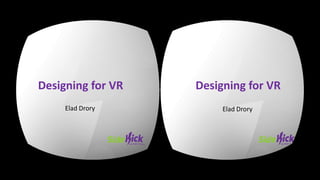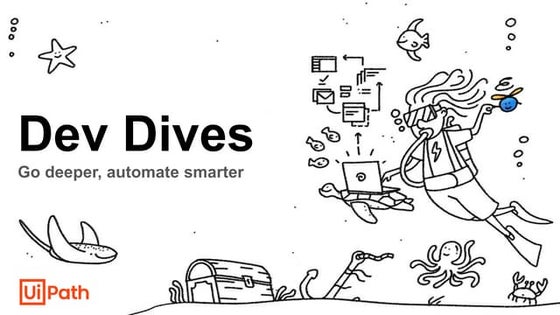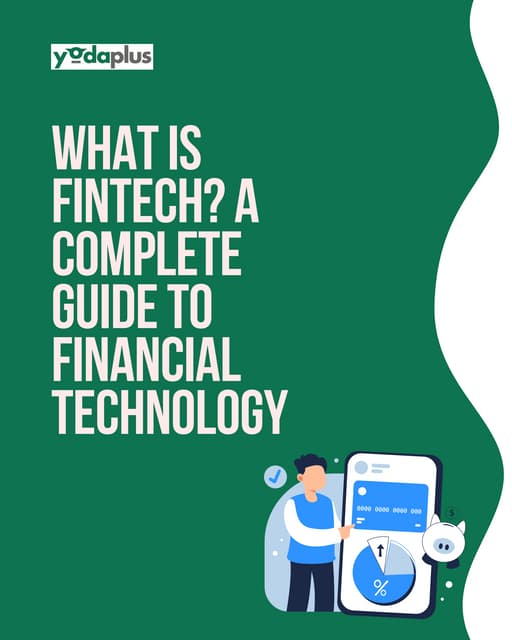Designing for VR
3 likes2,406 views
A short lecture I gave at the GameIS 2014 convention - about lessons learned from designing several VR games, including a launch title for Samsung Gear VR
1 of 13
Downloaded 34 times













Recommended
UX Design Patterns for Augmented Reality (AR) apps & games



UX Design Patterns for Augmented Reality (AR) apps & gamesKai Turner
Ėý
Augmented Reality apps and games for mobile are a developing technology. Some applications live up to expectations, while others fall short.
This is a review of the various design patterns to consider when designing an AR app, and some recommendations on how to make the most of the current technology.Shifting the Paradigm of Requirements Gathering - SP Summit 2013



Shifting the Paradigm of Requirements Gathering - SP Summit 2013Michelle Caldwell, PSM, SSGB
Ėý
Are you tired of attending or leading the same old boring requirements gathering sessions? Would you like to find a way to get stakeholders excited about requirements gathering? Then this session is for you!
Find out how to use collaborative play to build better solution requirements for SharePoint projects (or any other project for that matter). In this session I will introduce you to seriously fun ways to do work â Seriously! Learn how to tap into true innovation and uncover hidden business requirements. What are you waiting for come to my session and learn how to put these tools into action!
Development Strategies for Indie Games



Development Strategies for Indie GamesBenjamin Rivers
Ėý
How I learned to make a game and keep my sanity: practical strategies for self-propelled indie game designers and developers.Luca Marchetti - VR e applicazioni B2B



Luca Marchetti - VR e applicazioni B2BCodemotion
Ėý
La VR, oltre alle applicazioni ludiche, ha una serie di potenziali applicazioni nei settori industriali, training, marketing, architettura ed in generale in contesto B2B. Ci sono molte possibilità che si aprono, molte delle quali ancora da intuire. Qui presentiamo un piccolo showcase di applicazioni VR e Augmented reality che sono state realizzate e una serie di spunti per il futuro.SXSW 2019 VR Takeaways 



SXSW 2019 VR Takeaways Nathanael Girard
Ėý
A list of high level summaries of my takeaways from SXSW 2019 regarding Virtual Reality industry takeaways. For the Denver CO VR MeetupsBuilding a Mobile, Social, Location-Based Game in 5 Weeks



Building a Mobile, Social, Location-Based Game in 5 WeeksJennie Lees
Ėý
A 5-week experiment to practice Lean methods in game development by testing and iterating concepts around mobile, location-based social gaming and apps. Presented at GDC 2011.Emperors new clothes_digitalbarn_output_snakk



Emperors new clothes_digitalbarn_output_snakkkevinjohngallagher
Ėý
The document discusses various topics related to web development such as responsive design, HTML5, and open source software. It questions whether responsive design is truly about screen size or more about context. It also argues that CSS alone cannot account for all the factors like bandwidth, purpose, and context that are needed for responsive design. The document suggests that responsive design requires more than just CSS and needs an information architecture approach. It also discusses issues with images in responsive design and argues that responsive design may lead to bloated mobile pages if not implemented carefully. The document questions whether open source software is truly "free" and whether people have unrealistic expectations about ongoing support and updates without cost. Overall it advocates for a more balanced view of various web technologies andEmperors new clothes - digitalbarn2012



Emperors new clothes - digitalbarn2012kevinjohngallagher
Ėý
The document discusses various topics related to web development such as responsive design, HTML5, and open source software. It questions whether responsive design is truly about screen size or more about context. It also argues that CSS alone cannot account for all the factors like bandwidth, purpose, and context that are needed for responsive design. The document suggests that open source software is often expected to be free when in reality development costs money. It advocates that people's time has value and should not be expected for free.16 million downloads and 300.000 da us later when those numbers can't keep ...



16 million downloads and 300.000 da us later when those numbers can't keep ...Mary Chan
Ėý
Some of the biggest causes of a game studio to fail include: a demotivated and/or burned out team, lack of funds, legal trouble, not seeing the problems ahead, a neglected game and/or audience, internal arguments and publishing problems. At the start of January 2014, Critical Force Entertainment based of Kajaani, Finland had every single one of those challenges one way or another. This talk is intended to share the insights, learned lessons and best practices of how we succeeded through failing endlessly, even with a game that had a huge audience which we sadly never managed to properly monetize and the stigma of being a 'cloner'. Regardless of that, being creative and coming up with solutions to our problems on a step-by-step basis got us to become strong than we ever thought we could be. The main focus of this talk is on sharing our story of performing a complete startup turnaround regardless of the relative success we've had with our games. Topics include:
Team Culture
- we were lacking a defined team culture, so we decided to completely fix that Product management
- we never had anybody focus on this, now we do Legal Concerns
- we were facing 300+ websites that iframed our game from Kongregate, we show how we turned this into profit Funding
- we were making money, but didn't properly manage our budget.
Titanic Effect
- we were focusing too much on growing quantity instead of improving quality Community
- we had neglected our audience, now we're going to leverage them Partnerships
- finding the right partners to work with has saved us a lot of hassle for a worth-while share of our revenues.
We will be sharing concrete examples of how we tackled the above topics and will provide various forms of data, references, tips, best practices and learned lessons. Part of these can be found in the attached presentation draft.
Intended audience & prerequisites: Mostly intended for small-medium sized independent developers or developers intending to start their own company.
Session takeaways: We want developers to walk away with a new toolkit that allows them to see opportunity in every bit of adversity that might cross their path. Our story is but one of many, but will illustrate some of the most fundamentally necessary mindsets, perspectives and attitudes that developers can adopt to turn the biggest failure into something useful.Patrick Curry Meet Up



Patrick Curry Meet UpTsugi
Ėý
Patrick Curry has been developing mobile games since 2001. While mobile game development tools and distribution have improved dramatically, the industry has also become much more competitive. Developing mobile games is easier than ever before due to advanced game engines and tools, but it is also harder to succeed financially due to vast choice and short fad cycles. Curry focuses on rapid iterative development with small teams, outsourcing non-core work, and automating processes to stay efficient. He aims to help other developers by open-sourcing the tools and knowledge his company has gained.Why enter VR? Earnings and learnings from Into The Radius VR and new products...



Why enter VR? Earnings and learnings from Into The Radius VR and new products...DevGAMM Conference
Ėý
Two presenters from CM Games share narratives, insights, numbers, fails and plans on creating and nurturing premium live games for virtual reality, with Into The Radius VR and new products as the basisEmperors new clothes_jab



Emperors new clothes_jabkevinjohngallagher
Ėý
The document discusses responsive design and some of its challenges. It notes that while responsive design aims to apply different styles based on screen size, screen size is really just a proxy for context. It argues that responsive design cannot fully account for factors like bandwidth, purpose, and context. The document concludes that responsive design is limited because CSS was not designed to make complex decisions based on non-visual factors, and a better approach is to focus on information architecture rather than trying to shoehorn everything into CSS.Educational Games Design (STEG10 Keynote)



Educational Games Design (STEG10 Keynote)David Farrell
Ėý
The document discusses educational game design and summarizes key points from a presentation. It describes how educational games can model learning outcomes through game mechanics to provide deep learning. Two games from the e-Bug project are highlighted: a platform game for younger children about good and bad microbes, and a detective game for older children involving a sick character. The platform game was more successful due to extensive playtesting, while the detective game had usability issues from insufficient testing and a confusing phone interface metaphor.Jaakko Kemppainen - Pathfinder in VR - Mindtrek 2016



Jaakko Kemppainen - Pathfinder in VR - Mindtrek 2016Mindtrek
Ėý
The document discusses virtual reality game design. It summarizes the current state of VR, including the first generation of consumer devices, popular genres being conversions of old games and horror experiences. It outlines different expectations for VR - business opportunists seeking quick profits, gameplay explorers experimenting with mechanics, and meaning researchers studying player experience. It notes challenges including a small market, simulator sickness, and rethinking aesthetics without traditional cinematic techniques. It concludes that while the possibilities are unknown, further research is needed over the next few years to understand VR's potential.Kevinjohn Gallagher's: Emperors new clothes (WordUp Glasgow 2012)



Kevinjohn Gallagher's: Emperors new clothes (WordUp Glasgow 2012)kevinjohngallagher
Ėý
The document discusses responsive design and some of its limitations. It argues that responsive design is really about adapting to mobile rather than different contexts. While the goals of responsive design are good, it cannot truly account for all contexts and instead relies on screen size as a proxy. This leads to problems with things like images. The document concludes that responsive design alone is not enough and that information architecture must also be considered to properly adapt a site for different contexts beyond just screen size.Engaging Tomorrows Learners with Impact Focused Virtual Reality Games



Engaging Tomorrows Learners with Impact Focused Virtual Reality GamesClinical Tools, Inc
Ėý
Tanner B. Engaging Tomorrowâs Learners with Impact Focused Virtual Reality Games. Serious Play Conference; 2018 July 18; Buffalo, New York, United States.Early Days of Eye-Fi 



Early Days of Eye-Fi Vojvodina ICT Cluster
Ėý
The document discusses translating a passion and vision into a business idea. It describes how the founder of Eye-Fi was passionate about photography and helping people easily share photos. He and some co-founders discussed issues with sharing photos from cameras and initially tried different ideas before settling on the Eye-Fi card that makes cameras wireless. It then provides a quick timeline of Eye-Fi's founding, fundraising, product launches and partnerships over the years. The document also offers advice on brainstorming, evaluating and focusing on ideas.Focus fast bigd15_roger_belveal_2015-09-19



Focus fast bigd15_roger_belveal_2015-09-19Roger Belveal
Ėý
Focus Fast : A Design Think
BigDesign 2015
By Roger Belveal, www.belveal.com @belvealUX
See art at http://randomartdallas.com/What the hell is Virtual Reality?



What the hell is Virtual Reality?Francesco Napoletano
Ėý
Virtual reality (VR) is an artificial computer-generated simulation that immerses the user by making them feel like they are experiencing the simulated reality firsthand. Augmented reality (AR) layers computer-generated enhancements on existing reality to make it more interactive. 360 degree videos allow viewing in any direction during playback. While VR and AR have been theorized since the 1950s, mainstream use has increased in recent years with cheaper hardware options like smartphones, along with applications in gaming, video, and e-commerce.Vlad Micu, Head of Studio Critical Force Entertainment - The complete game st...



Vlad Micu, Head of Studio Critical Force Entertainment - The complete game st...How to Web
Ėý
This presentation is intended to share the insights, learned lessons and best practices of how our startup succeeded through failing endlessly, even with a game that had a huge audience which we sadly never managed to properly monetizeVR Introduction



VR IntroductionAdam Chen
Ėý
There is a lot of interest in Virtual Reality, but many people confuse it with 3D or AR (Augmented Reality). This presentation looks at the differences and surveys what's available in the market now.UX Australia 2015 Redux



UX Australia 2015 ReduxAnthony Clark
Ėý
4 summaries, 2 lunches, 7 mentions, and 1 conference in 10 minutes. A UX Australia 2015 redux by Anthony Clark.Google io 2015, Trip Report



Google io 2015, Trip ReportDiana Laboy-Rush
Ėý
Google IO 2015 featured announcements around major Google platforms and technologies:
- Android Wear smartwatches were highlighted as providing always-on access to notifications and apps with new customization options and over 4000 apps.
- Project Soli was unveiled as a tiny radar chip that can enable gesture control by sensing subtle hand motions, potentially allowing hand gestures to serve as virtual controls.
- Project Jacquard aimed to bring interactivity to textiles at scale by developing woven layers with touch sensors similar to printed circuits, allowing garments to interface with digital devices.Game Designer's Journey



Game Designer's JourneyAndrew Dotsenko
Ėý
Andrii Dotsenko shares his experience as a game designer at Ubisoft Kiev. He worked on games like Far Cry 4. Game design involves imagining rules and mechanics to create fun experiences for players. It takes time and failed prototypes to develop this skill. Designers must learn to communicate ideas clearly and listen to feedback from teammates with different perspectives. While ideas are important, the real work is in interactive prototyping to prove a concept.The Complete Game Startup Turnaround - When even 27 million downloads and 300...



The Complete Game Startup Turnaround - When even 27 million downloads and 300...Vlad Micu
Ėý
Some of the biggest causes of a game studio to fail include: a demotivated and/or burned out team, lack of funds, legal trouble, not seeing the problems ahead, a neglected game and/or audience, internal arguments and publishing problems. At the start of January 2014, Critical Force Entertainment based of Kajaani, Finland had every single one of those challenges one way or another. This talk is intended to share the insights, learned lessons and best practices of how we succeeded through failing endlessly, even with a game that had a huge audience which we sadly never managed to properly monetize. Regardless of that, being creative and coming up with solutions to our problems on a step-by-step basis got us to become strong than we ever thought we could be. The main focus of this talk is on sharing our story of performing a complete startup turnaround regardless of the relative success we've had with our games. Topics include:
I will be sharing concrete examples of how we tackled the above topics and will provide various forms of data, references, tips, best practices and learned lessons.Chris Paton UX Australia 2013 - Our billion-dollar baby: From greed to good



Chris Paton UX Australia 2013 - Our billion-dollar baby: From greed to goodChris Paton
Ėý
"If you won $1 billon, how much would you give to charity"
Jaro is a "Gamified Crowd Funding Platform" that launched in April this year. Users of Jaro pay to play in the knockout tournament for a cash prize that is split between charitable causes and one lucky winner. The best part is that our users get a say in how much is given to each.
Existing as a startup within the Vivant agency, balancing agency practices (deliverables) with a startup mentality (ship it) has been a long and unique journey for the Vivant UX team. Many mistakes and paradigm shifts occurred along the way.
Chris will take you through the Journey from the first patent lodgement in 2008 through Jaro's launch in 2013 and beyond:
- The many pivots Jaro went through and how it affected who their users and target market were.
- How as a team they got stuck at the very first hurdle, how they were able to shake it off and move forward.
- How they designed features that nobody knew how to start, by failing fast and failing hard.
- How they moved from a tangled mess of features towards a seamless experience.
- Finally, the story post launch. What they are doing to gain traction in the market and other lessons learned along the way.Intro to game design



Intro to game designDevin Becker
Ėý
This document provides an overview of game design. It discusses what game design is, the design process, and resources for getting started in game design. Specifically, it notes that game design involves creating an interactive system using rules to engage players. The design process involves iterating through ideas, prototypes, playtesting, and polishing. It recommends starting simple, such as by modifying existing board games, and gaining experience through game jams, online resources, and internships.UiPath Automation Developer Associate Training Series 2025 - Session 1



UiPath Automation Developer Associate Training Series 2025 - Session 1DianaGray10
Ėý
Welcome to UiPath Automation Developer Associate Training Series 2025 - Session 1.
In this session, we will cover the following topics:
Introduction to RPA & UiPath Studio
Overview of RPA and its applications
Introduction to UiPath Studio
Variables & Data Types
Control Flows
You are requested to finish the following self-paced training for this session:
Variables, Constants and Arguments in Studio 2 modules - 1h 30m - https://academy.uipath.com/courses/variables-constants-and-arguments-in-studio
Control Flow in Studio 2 modules - 2h 15m - https:/academy.uipath.com/courses/control-flow-in-studio
âïļ For any questions you may have, please use the dedicated Forum thread. You can tag the hosts and mentors directly and they will reply as soon as possible. Leadership u automatizaciji: RPA priÄe iz prakse!



Leadership u automatizaciji: RPA priÄe iz prakse!UiPathCommunity
Ėý
DobrodoÅĄli na "AI Powered Automation Leadership Talks", online dogaÄaj koji okuplja senior lidere i menadÅūere iz razliÄitih industrija kako bi podelili svoja iskustva, izazove i strategije u oblasti RPA (Robotic Process Automation). Ovaj dogaÄaj pruÅūa priliku da zavirite u naÄin razmiÅĄljanja ljudi koji donose kljuÄne odluke u automatizaciji i liderstvu.
ð Kroz panel diskusiju sa tri izuzetna struÄnjaka, istraÅūiÄemo:
Kako uspeÅĄno zapoÄeti i skalirati RPA projekte u organizacijama.
Koji su najveÄi izazovi u implementaciji RPA-a i kako ih prevaziÄi.
Na koje naÄine automatizacija menja radne procese i pomaÅūe timovima da ostvare viÅĄe.
Bez obzira na vaÅĄe iskustvo sa UiPath-om ili RPA uopÅĄte, ovaj dogaÄaj je osmiÅĄljen kako bi bio koristan svima â od menadÅūera do tehniÄkih lidera, i svima koji Åūele da unaprede svoje razumevanje automatizacije.
PridruÅūite nam se i iskoristite ovu jedinstvenu priliku da nauÄite od onih koji vode automatizaciju u svojim organizacijama. Pripremite svoja pitanja i inspiraciju za sledeÄe korake u vaÅĄoj RPA strategiji!More Related Content
Similar to Designing for VR (20)
Emperors new clothes - digitalbarn2012



Emperors new clothes - digitalbarn2012kevinjohngallagher
Ėý
The document discusses various topics related to web development such as responsive design, HTML5, and open source software. It questions whether responsive design is truly about screen size or more about context. It also argues that CSS alone cannot account for all the factors like bandwidth, purpose, and context that are needed for responsive design. The document suggests that open source software is often expected to be free when in reality development costs money. It advocates that people's time has value and should not be expected for free.16 million downloads and 300.000 da us later when those numbers can't keep ...



16 million downloads and 300.000 da us later when those numbers can't keep ...Mary Chan
Ėý
Some of the biggest causes of a game studio to fail include: a demotivated and/or burned out team, lack of funds, legal trouble, not seeing the problems ahead, a neglected game and/or audience, internal arguments and publishing problems. At the start of January 2014, Critical Force Entertainment based of Kajaani, Finland had every single one of those challenges one way or another. This talk is intended to share the insights, learned lessons and best practices of how we succeeded through failing endlessly, even with a game that had a huge audience which we sadly never managed to properly monetize and the stigma of being a 'cloner'. Regardless of that, being creative and coming up with solutions to our problems on a step-by-step basis got us to become strong than we ever thought we could be. The main focus of this talk is on sharing our story of performing a complete startup turnaround regardless of the relative success we've had with our games. Topics include:
Team Culture
- we were lacking a defined team culture, so we decided to completely fix that Product management
- we never had anybody focus on this, now we do Legal Concerns
- we were facing 300+ websites that iframed our game from Kongregate, we show how we turned this into profit Funding
- we were making money, but didn't properly manage our budget.
Titanic Effect
- we were focusing too much on growing quantity instead of improving quality Community
- we had neglected our audience, now we're going to leverage them Partnerships
- finding the right partners to work with has saved us a lot of hassle for a worth-while share of our revenues.
We will be sharing concrete examples of how we tackled the above topics and will provide various forms of data, references, tips, best practices and learned lessons. Part of these can be found in the attached presentation draft.
Intended audience & prerequisites: Mostly intended for small-medium sized independent developers or developers intending to start their own company.
Session takeaways: We want developers to walk away with a new toolkit that allows them to see opportunity in every bit of adversity that might cross their path. Our story is but one of many, but will illustrate some of the most fundamentally necessary mindsets, perspectives and attitudes that developers can adopt to turn the biggest failure into something useful.Patrick Curry Meet Up



Patrick Curry Meet UpTsugi
Ėý
Patrick Curry has been developing mobile games since 2001. While mobile game development tools and distribution have improved dramatically, the industry has also become much more competitive. Developing mobile games is easier than ever before due to advanced game engines and tools, but it is also harder to succeed financially due to vast choice and short fad cycles. Curry focuses on rapid iterative development with small teams, outsourcing non-core work, and automating processes to stay efficient. He aims to help other developers by open-sourcing the tools and knowledge his company has gained.Why enter VR? Earnings and learnings from Into The Radius VR and new products...



Why enter VR? Earnings and learnings from Into The Radius VR and new products...DevGAMM Conference
Ėý
Two presenters from CM Games share narratives, insights, numbers, fails and plans on creating and nurturing premium live games for virtual reality, with Into The Radius VR and new products as the basisEmperors new clothes_jab



Emperors new clothes_jabkevinjohngallagher
Ėý
The document discusses responsive design and some of its challenges. It notes that while responsive design aims to apply different styles based on screen size, screen size is really just a proxy for context. It argues that responsive design cannot fully account for factors like bandwidth, purpose, and context. The document concludes that responsive design is limited because CSS was not designed to make complex decisions based on non-visual factors, and a better approach is to focus on information architecture rather than trying to shoehorn everything into CSS.Educational Games Design (STEG10 Keynote)



Educational Games Design (STEG10 Keynote)David Farrell
Ėý
The document discusses educational game design and summarizes key points from a presentation. It describes how educational games can model learning outcomes through game mechanics to provide deep learning. Two games from the e-Bug project are highlighted: a platform game for younger children about good and bad microbes, and a detective game for older children involving a sick character. The platform game was more successful due to extensive playtesting, while the detective game had usability issues from insufficient testing and a confusing phone interface metaphor.Jaakko Kemppainen - Pathfinder in VR - Mindtrek 2016



Jaakko Kemppainen - Pathfinder in VR - Mindtrek 2016Mindtrek
Ėý
The document discusses virtual reality game design. It summarizes the current state of VR, including the first generation of consumer devices, popular genres being conversions of old games and horror experiences. It outlines different expectations for VR - business opportunists seeking quick profits, gameplay explorers experimenting with mechanics, and meaning researchers studying player experience. It notes challenges including a small market, simulator sickness, and rethinking aesthetics without traditional cinematic techniques. It concludes that while the possibilities are unknown, further research is needed over the next few years to understand VR's potential.Kevinjohn Gallagher's: Emperors new clothes (WordUp Glasgow 2012)



Kevinjohn Gallagher's: Emperors new clothes (WordUp Glasgow 2012)kevinjohngallagher
Ėý
The document discusses responsive design and some of its limitations. It argues that responsive design is really about adapting to mobile rather than different contexts. While the goals of responsive design are good, it cannot truly account for all contexts and instead relies on screen size as a proxy. This leads to problems with things like images. The document concludes that responsive design alone is not enough and that information architecture must also be considered to properly adapt a site for different contexts beyond just screen size.Engaging Tomorrows Learners with Impact Focused Virtual Reality Games



Engaging Tomorrows Learners with Impact Focused Virtual Reality GamesClinical Tools, Inc
Ėý
Tanner B. Engaging Tomorrowâs Learners with Impact Focused Virtual Reality Games. Serious Play Conference; 2018 July 18; Buffalo, New York, United States.Early Days of Eye-Fi 



Early Days of Eye-Fi Vojvodina ICT Cluster
Ėý
The document discusses translating a passion and vision into a business idea. It describes how the founder of Eye-Fi was passionate about photography and helping people easily share photos. He and some co-founders discussed issues with sharing photos from cameras and initially tried different ideas before settling on the Eye-Fi card that makes cameras wireless. It then provides a quick timeline of Eye-Fi's founding, fundraising, product launches and partnerships over the years. The document also offers advice on brainstorming, evaluating and focusing on ideas.Focus fast bigd15_roger_belveal_2015-09-19



Focus fast bigd15_roger_belveal_2015-09-19Roger Belveal
Ėý
Focus Fast : A Design Think
BigDesign 2015
By Roger Belveal, www.belveal.com @belvealUX
See art at http://randomartdallas.com/What the hell is Virtual Reality?



What the hell is Virtual Reality?Francesco Napoletano
Ėý
Virtual reality (VR) is an artificial computer-generated simulation that immerses the user by making them feel like they are experiencing the simulated reality firsthand. Augmented reality (AR) layers computer-generated enhancements on existing reality to make it more interactive. 360 degree videos allow viewing in any direction during playback. While VR and AR have been theorized since the 1950s, mainstream use has increased in recent years with cheaper hardware options like smartphones, along with applications in gaming, video, and e-commerce.Vlad Micu, Head of Studio Critical Force Entertainment - The complete game st...



Vlad Micu, Head of Studio Critical Force Entertainment - The complete game st...How to Web
Ėý
This presentation is intended to share the insights, learned lessons and best practices of how our startup succeeded through failing endlessly, even with a game that had a huge audience which we sadly never managed to properly monetizeVR Introduction



VR IntroductionAdam Chen
Ėý
There is a lot of interest in Virtual Reality, but many people confuse it with 3D or AR (Augmented Reality). This presentation looks at the differences and surveys what's available in the market now.UX Australia 2015 Redux



UX Australia 2015 ReduxAnthony Clark
Ėý
4 summaries, 2 lunches, 7 mentions, and 1 conference in 10 minutes. A UX Australia 2015 redux by Anthony Clark.Google io 2015, Trip Report



Google io 2015, Trip ReportDiana Laboy-Rush
Ėý
Google IO 2015 featured announcements around major Google platforms and technologies:
- Android Wear smartwatches were highlighted as providing always-on access to notifications and apps with new customization options and over 4000 apps.
- Project Soli was unveiled as a tiny radar chip that can enable gesture control by sensing subtle hand motions, potentially allowing hand gestures to serve as virtual controls.
- Project Jacquard aimed to bring interactivity to textiles at scale by developing woven layers with touch sensors similar to printed circuits, allowing garments to interface with digital devices.Game Designer's Journey



Game Designer's JourneyAndrew Dotsenko
Ėý
Andrii Dotsenko shares his experience as a game designer at Ubisoft Kiev. He worked on games like Far Cry 4. Game design involves imagining rules and mechanics to create fun experiences for players. It takes time and failed prototypes to develop this skill. Designers must learn to communicate ideas clearly and listen to feedback from teammates with different perspectives. While ideas are important, the real work is in interactive prototyping to prove a concept.The Complete Game Startup Turnaround - When even 27 million downloads and 300...



The Complete Game Startup Turnaround - When even 27 million downloads and 300...Vlad Micu
Ėý
Some of the biggest causes of a game studio to fail include: a demotivated and/or burned out team, lack of funds, legal trouble, not seeing the problems ahead, a neglected game and/or audience, internal arguments and publishing problems. At the start of January 2014, Critical Force Entertainment based of Kajaani, Finland had every single one of those challenges one way or another. This talk is intended to share the insights, learned lessons and best practices of how we succeeded through failing endlessly, even with a game that had a huge audience which we sadly never managed to properly monetize. Regardless of that, being creative and coming up with solutions to our problems on a step-by-step basis got us to become strong than we ever thought we could be. The main focus of this talk is on sharing our story of performing a complete startup turnaround regardless of the relative success we've had with our games. Topics include:
I will be sharing concrete examples of how we tackled the above topics and will provide various forms of data, references, tips, best practices and learned lessons.Chris Paton UX Australia 2013 - Our billion-dollar baby: From greed to good



Chris Paton UX Australia 2013 - Our billion-dollar baby: From greed to goodChris Paton
Ėý
"If you won $1 billon, how much would you give to charity"
Jaro is a "Gamified Crowd Funding Platform" that launched in April this year. Users of Jaro pay to play in the knockout tournament for a cash prize that is split between charitable causes and one lucky winner. The best part is that our users get a say in how much is given to each.
Existing as a startup within the Vivant agency, balancing agency practices (deliverables) with a startup mentality (ship it) has been a long and unique journey for the Vivant UX team. Many mistakes and paradigm shifts occurred along the way.
Chris will take you through the Journey from the first patent lodgement in 2008 through Jaro's launch in 2013 and beyond:
- The many pivots Jaro went through and how it affected who their users and target market were.
- How as a team they got stuck at the very first hurdle, how they were able to shake it off and move forward.
- How they designed features that nobody knew how to start, by failing fast and failing hard.
- How they moved from a tangled mess of features towards a seamless experience.
- Finally, the story post launch. What they are doing to gain traction in the market and other lessons learned along the way.Intro to game design



Intro to game designDevin Becker
Ėý
This document provides an overview of game design. It discusses what game design is, the design process, and resources for getting started in game design. Specifically, it notes that game design involves creating an interactive system using rules to engage players. The design process involves iterating through ideas, prototypes, playtesting, and polishing. It recommends starting simple, such as by modifying existing board games, and gaining experience through game jams, online resources, and internships.Why enter VR? Earnings and learnings from Into The Radius VR and new products...



Why enter VR? Earnings and learnings from Into The Radius VR and new products...DevGAMM Conference
Ėý
Recently uploaded (20)
UiPath Automation Developer Associate Training Series 2025 - Session 1



UiPath Automation Developer Associate Training Series 2025 - Session 1DianaGray10
Ėý
Welcome to UiPath Automation Developer Associate Training Series 2025 - Session 1.
In this session, we will cover the following topics:
Introduction to RPA & UiPath Studio
Overview of RPA and its applications
Introduction to UiPath Studio
Variables & Data Types
Control Flows
You are requested to finish the following self-paced training for this session:
Variables, Constants and Arguments in Studio 2 modules - 1h 30m - https://academy.uipath.com/courses/variables-constants-and-arguments-in-studio
Control Flow in Studio 2 modules - 2h 15m - https:/academy.uipath.com/courses/control-flow-in-studio
âïļ For any questions you may have, please use the dedicated Forum thread. You can tag the hosts and mentors directly and they will reply as soon as possible. Leadership u automatizaciji: RPA priÄe iz prakse!



Leadership u automatizaciji: RPA priÄe iz prakse!UiPathCommunity
Ėý
DobrodoÅĄli na "AI Powered Automation Leadership Talks", online dogaÄaj koji okuplja senior lidere i menadÅūere iz razliÄitih industrija kako bi podelili svoja iskustva, izazove i strategije u oblasti RPA (Robotic Process Automation). Ovaj dogaÄaj pruÅūa priliku da zavirite u naÄin razmiÅĄljanja ljudi koji donose kljuÄne odluke u automatizaciji i liderstvu.
ð Kroz panel diskusiju sa tri izuzetna struÄnjaka, istraÅūiÄemo:
Kako uspeÅĄno zapoÄeti i skalirati RPA projekte u organizacijama.
Koji su najveÄi izazovi u implementaciji RPA-a i kako ih prevaziÄi.
Na koje naÄine automatizacija menja radne procese i pomaÅūe timovima da ostvare viÅĄe.
Bez obzira na vaÅĄe iskustvo sa UiPath-om ili RPA uopÅĄte, ovaj dogaÄaj je osmiÅĄljen kako bi bio koristan svima â od menadÅūera do tehniÄkih lidera, i svima koji Åūele da unaprede svoje razumevanje automatizacije.
PridruÅūite nam se i iskoristite ovu jedinstvenu priliku da nauÄite od onih koji vode automatizaciju u svojim organizacijama. Pripremite svoja pitanja i inspiraciju za sledeÄe korake u vaÅĄoj RPA strategiji!The Constructor's Digital Transformation Playbook: Reducing Risk With Technology



The Constructor's Digital Transformation Playbook: Reducing Risk With TechnologyAggregage
Ėý
https://www.professionalconstructorcentral.com/frs/27678427/the-constructor-s-digital-transformation-playbook--reducing-risk-with-technology
Reduce risk and boost efficiency with digital transformation in construction. Join us to explore how AI, automation, and data-driven insights can improve project safety and streamline operations.William Maclyn Murphy McRae - A Seasoned Professional Renowned



William Maclyn Murphy McRae - A Seasoned Professional RenownedWilliam Maclyn Murphy McRae
Ėý
William Maclyn Murphy McRae, a logistics expert with 9+ years of experience, is known for optimizing supply chain operations and consistently exceeding industry standards. His strategic approach, combined with hands-on execution, has streamlined distribution processes, reduced lead times, and consistently delivered exceptional results.NSFW AI Chatbot Development Costs: What You Need to Know



NSFW AI Chatbot Development Costs: What You Need to KnowSoulmaite
Ėý
Are you considering building an NSFW AI chatbot ?Understanding the costs involved is crucial before starting your project. This PDF explores the key cost factors, including AI model customization, API integration, content filtering systems, and ongoing maintenance expenses. Learn how different pricing models impact the development budget and discover cost-saving strategies without compromising quality.GDG Cloud Southlake #40: Brandon Stokes: How to Build a Great Product



GDG Cloud Southlake #40: Brandon Stokes: How to Build a Great ProductJames Anderson
Ėý
How to Build a Great Product
Being a tech entrepreneur is about providing a remarkable product or service that serves the needs of its customers better, faster, and cheaper than anything else. The goal is to "make something people want" which we call, product market fit.
But how do we get there? We'll explore the process of taking an idea to product market fit (PMF), how you know you have true PMF, and how your product strategies differ pre-PMF from post-PMF.
Brandon is a 3x founder, 1x exit, ex-banker & corporate strategist, car dealership owner, and alumnus of Techstars & Y Combinator. He enjoys building products and services that impact people for the better.
Brandon has had 3 different careers (banking, corporate finance & strategy, technology) in 7 different industries; Investment Banking, CPG, Media & Entertainment, Telecommunications, Consumer application, Automotive, & Fintech/Insuretech.
He's an idea to revenue leader and entrepreneur that helps organizations build products and processes, hire talent, test & iterate quickly, collect feedback, and grow in unregulated and heavily regulated industries.Understanding & Utilizing SharePoint Advanced Management



Understanding & Utilizing SharePoint Advanced ManagementDrew Madelung
Ėý
Drew Madelung is a Cloud Solutions Architect and a Microsoft MVP for Office Apps and Services. He helps organizations realize what is possible with Microsoft 365 & Azure, onboard them in a secure and compliant way, and drive sustained adoption for those solutions. He is experienced in a range of technologies but specializes in the collaboration and teamwork workspaces such as Microsoft Teams, SharePoint, and OneDrive. He has helped deploy Microsoft 365 to multiple global companies while rolling out modern information protection and information governance technologies. He has been doing Microsoft consulting for 10+ years with a strength in security & compliance solutions.Webinar: LF Energy GEISA: Addressing edge interoperability at the meter



Webinar: LF Energy GEISA: Addressing edge interoperability at the meterDanBrown980551
Ėý
This webinar will introduce the Grid Edge Security and Interoperability Alliance, or GEISA, an effort within LF Energy to address application interoperability at the very edge of the utility network: meters and other distribution automation devices. Over the last decade platform manufacturers have introduced the ability to run applications on electricity meters and other edge devices. Unfortunately, while many of these efforts have been built on Linux, they havenât been interoperable. APIs and execution environment have varied from one manufacturer to the next making it impossible for utilities to obtain applications that they can run across a fleet of different devices. For utilities that want to minimize their supply chain risk by obtaining equipment from multiple suppliers, they are forced to run and maintain multiple separate management systems. Applications available for one device may need to be ported to run on another, or they may not be available at all.
GEISA addresses this by creating a vendor neutral specification for utility edge computing environments. This webinar will discuss why GEISA is important to utilities, the specific issues GEISA will solve and the new opportunities it creates for utilities, platform vendors, and application vendors. Agentic AI: The 2025 Next-Gen Automation Guide



Agentic AI: The 2025 Next-Gen Automation GuideThoughtminds
Ėý
Introduction to Agentic AI: Explains how it differs from traditional automation and its ability to make independent decisions.
Comparison with Generative AI: A structured comparison between Generative AI (content creation) and Agentic AI (autonomous action-taking).
Technical Breakdown: Covers core components such as LLMs, reinforcement learning, and cloud infrastructure that power Agentic AI.
Real-World Use Cases (2025 & Beyond): Examines how Agentic AI is transforming industries like insurance, healthcare, retail, finance, and cybersecurity.
Business Impact & ROI: Discusses case studies from Unilever, FedEx, and more, showcasing cost savings and operational efficiency improvements.
Challenges & Risks: Highlights bias, security threats, regulatory compliance, and workforce reskilling as critical challenges in AI adoption.
5-Step Implementation Strategy: A practical roadmap to help organizations integrate Agentic AI seamlessly.
Future Predictions (2025-2030): Forecasts on AI-driven workforce evolution, industry disruptions, and the rise of Quantum AI.Dev Dives: Unlock the future of automation with UiPath Agent Builder



Dev Dives: Unlock the future of automation with UiPath Agent BuilderUiPathCommunity
Ėý
This webinar will offer you a first look at the powerful capabilities of UiPath Agent Builder, designed to streamline your automation processes and enhance your workflow efficiency.
ð During the session, you will:
- Discover how to build agents with low-code experience, making it accessible for both developers and business users.
- Learn how to leverage automations and activities as tools within your agents, enabling them to handle complex and dynamic workflows.
- Gain insights into the AI Trust Layer, which provides robust management and monitoring capabilities, ensuring trust and transparency in your automation processes.
- See how agents can be deployed and integrated with your existing UiPath cloud and Studio environments.
ðĻâðŦ Speaker:
Zach Eslami, Sr. Manager, Product Management Director, UiPath
âĐ Register for our upcoming Dev Dives March session:
Unleash the power of macOS Automation with UiPath
ð AMER: https://bit.ly/Dev_Dives_AMER_March
ð EMEA & APJ:https://bit.ly/Dev_Dives_EMEA_APJ_March
This session was streamed live on February 27, 2025, 15:00 GMT.
Check out future Dev Dives 2025 sessions at:
ðĐ https://bit.ly/Dev_Dives_2025
Revolutionizing Field Service: How LLMs Are Powering Smarter Knowledge Access...



Revolutionizing Field Service: How LLMs Are Powering Smarter Knowledge Access...Earley Information Science
Ėý
Revolutionizing Field Service with LLM-Powered Knowledge Management
Field service technicians need instant access to accurate repair information, but outdated knowledge systems often create frustrating delays. Large Language Models (LLMs) are changing the gameâenhancing knowledge retrieval, streamlining troubleshooting, and reducing technician dependency on senior staff.
In this webinar, Seth Earley and industry experts Sanjay Mehta, and Heather Eisenbraun explore how LLMs and Retrieval-Augmented Generation (RAG) are transforming field service operations. Discover how AI-powered knowledge management is improving efficiency, reducing downtime, and elevating service quality.
LLMs for Instant Knowledge Retrieval â How AI-driven search dramatically cuts troubleshooting time.
Structured Data & AI â Why high-quality, organized knowledge is essential for LLM success.
Real-World Implementation â Lessons from deploying LLM-powered knowledge tools in field service.
Business Impact â How AI reduces service delays, optimizes workflows, and enhances technician productivity.
Empower your field service teams with AI-driven knowledge access. Watch the webinar to see how LLMs are revolutionizing service efficiency.TrustArc Webinar: State of State Privacy Laws



TrustArc Webinar: State of State Privacy LawsTrustArc
Ėý
The U.S. data privacy landscape is rapidly proliferating, with 20 states enacting comprehensive privacy laws as of November 2024. These laws cover consumer rights, data collection and use including for sensitive data, data security, transparency, and various enforcement mechanisms and penalties for non-compliance.
Navigating this patchwork of state-level laws is crucial for businesses to ensure compliance and requires a combination of strategic planning, operational adjustments, and technology to be proactive.
Join leading experts from TrustArc, the Future of Privacy Forum, and Venable for an insightful webinar exploring the evolution of state data privacy laws and practical strategies to maintain compliance in 2025.
This webinar will review:
- A comprehensive overview of each stateâs privacy regulations and the latest updates
- Practical considerations to help your business achieve regulatory compliance across multiple states
- Actionable insights to future-proof your business for 2025THE BIG TEN BIOPHARMACEUTICAL MNCs: GLOBAL CAPABILITY CENTERS IN INDIA



THE BIG TEN BIOPHARMACEUTICAL MNCs: GLOBAL CAPABILITY CENTERS IN INDIASrivaanchi Nathan
Ėý
This business intelligence report, "The Big Ten Biopharmaceutical MNCs: Global Capability Centers in India", provides an in-depth analysis of the operations and contributions of the Global Capability Centers (GCCs) of ten leading biopharmaceutical multinational corporations in India. The report covers AstraZeneca, Bayer, Bristol Myers Squibb, GlaxoSmithKline (GSK), Novartis, Sanofi, Roche, Pfizer, Novo Nordisk, and Eli Lilly. In this report each company's GCC is profiled with details on location, workforce size, investment, and the strategic roles these centers play in global business operations, research and development, and information technology and digital innovation.Caching for Performance Masterclass: Caching Strategies



Caching for Performance Masterclass: Caching StrategiesScyllaDB
Ėý
Exploring the tradeoffs of common caching strategies â and a look at the architectural differences.
- Which strategies exist
- When to apply different strategies
- ScyllaDB cache designWhat is FinTech A Complete Guide to Financial Technology.pdf



What is FinTech A Complete Guide to Financial Technology.pdf Yodaplus Technologies Private Limited
Ėý
It is an in-depth exploration of how technology is transforming the financial sector. Covering the evolution of FinTech from credit cards to AI-driven banking, this guide explains key innovations such as blockchain, DeFi, AI-powered assistants, and central bank digital currencies (CBDCs). Learn how FinTech is enhancing banking, lending, and payments through automation, data analytics, and decentralized solutions. Whether you're a financial professional or just curious about the future of digital finance, this guide offers valuable insights into the rapidly evolving FinTech landscape.Bedrock Data Automation (Preview): Simplifying Unstructured Data Processing



Bedrock Data Automation (Preview): Simplifying Unstructured Data ProcessingZilliz
Ėý
Bedrock Data Automation (BDA) is a cloud-based service that simplifies the process of extracting valuable insights from unstructured contentâsuch as documents, images, video, and audio. Come learn how BDA leverages generative AI to automate the transformation of multi-modal data into structured formats, enabling developers to build applications and automate complex workflows with greater speed and accuracy.SECURE BLOCKCHAIN FOR ADMISSION PROCESSING IN EDUCATIONAL INSTITUTIONS.pdf



SECURE BLOCKCHAIN FOR ADMISSION PROCESSING IN EDUCATIONAL INSTITUTIONS.pdfspub1985
Ėý
SECURE BLOCKCHAIN FOR ADMISSION PROCESSING IN EDUCATIONAL INSTITUTIONS.pdfQuantum Computing Quick Research Guide by Arthur Morgan



Quantum Computing Quick Research Guide by Arthur MorganArthur Morgan
Ėý
This is a Quick Research Guide (QRG).
QRGs include the following:
- A brief, high-level overview of the QRG topic.
- A milestone timeline for the QRG topic.
- Links to various free online resource materials to provide a deeper dive into the QRG topic.
- Conclusion and a recommendation for at least two books available in the SJPL system on the QRG topic.
QRGs planned for the series:
- Artificial Intelligence QRG
- Quantum Computing QRG
- Big Data Analytics QRG (coming 2025)
- Spacecraft Guidance, Navigation & Control QRG (coming 2026)
- UK Home Computing & The Birth of ARM QRG (coming 2027)
Any questions or comments?
- Please contact Arthur Morgan at art_morgan@att.net.
100% human made.Caching for Performance Masterclass: Caching at Scale



Caching for Performance Masterclass: Caching at ScaleScyllaDB
Ėý
Weighing caching considerations for use cases with different technical requirements and growth expectations.
- Request coalescing
- Negative sharding
- Rate limiting
- Sharding and scalingRevolutionizing Field Service: How LLMs Are Powering Smarter Knowledge Access...



Revolutionizing Field Service: How LLMs Are Powering Smarter Knowledge Access...Earley Information Science
Ėý
What is FinTech A Complete Guide to Financial Technology.pdf



What is FinTech A Complete Guide to Financial Technology.pdf Yodaplus Technologies Private Limited
Ėý
Designing for VR
- 1. Designing for VR Elad Drory Designing for VR Elad Drory
- 2. Topics âĒWhy VR? âĒWelcoming our players âĒThe elephant in the room âĒBest practices âĒWhat this means for game design âĒRethinking the world âĒRethinking pace and flow âĒProduction and budget âĒThe future!
- 3. Why VR? âĒWe are on the edge of a huge leap forward in VR âĒHardware is taking huge steps forward, and will keep improving âĒIn March 2014, Facebook bought Oculus for $2 Billion âĒSamsungâs Galaxy Note 4 and future phones will support Gear VR. 10 million VR-capable phones in 2015. âĒGoogle and other companies invested over $500 million in Magic Leap, a VR/AR company âĒAs game designers, working in VR tests our ability to create truly immersive experiences âĒBecause, seriously, VR is awesome
- 4. Welcoming our players âĒAs VR pioneers, one of our first goals is to help people transition into this new medium âĒRemember that as developers, we will quickly get used to VR, and forget how shocking the transition can be âĒWe have to introduce players to VR gently, even at the expense of gameplay
- 5. The elephant in the room âĒOculus is working hard to prevent motion sickness âĒAs developers, we have an interest in this as well âĒAt its core, motion sickness happens because of a mis-match between our senses. âĒWhat our eyes see doesnât match what our body feels, creating confusion
- 6. And speaking of elephants https://www.youtube.com/watch?v=7OXixY2weuk
- 7. Best practices âĒNever ever take control of the playerâs head âĒThis includes head bobbing, camera shakes, and zooming âĒFixed position in games is the most comfortable, and thereâs a lot of possibilities to explore âĒIdeally, let the player control their own movement and set their own pace âĒIf you must move the player: âĒMove at a constant speed in one direction, donât change direction or axis suddenly âĒHelp them understand where theyâre going by using lighting and architecture âĒAvoid gameplay that requires looking away from direction of travel âĒRead the Best Practices document!
- 8. A little demonstration ROMANS VIDEO GOES HERE
- 9. Rethinking the world âĒHUD must be part of the world, it canât be glued on screen âĒDonât strive for too much realism âĒScale is an easy and extremely powerful tool â feeling bigger or smaller is fun! âĒLet players get up close and personal with stuff âĒNo more cheating â you canât introduce objects into the game from âoff-screenâ
- 10. Rethinking pace and flow âĒAdd a lot of breaks in the action âĒLet players explore, remember that just being in the world is magical âĒThink of ways to encourage and reward exploration âĒDonât forget that itâs a game. Have clear objectives and sense of progress.
- 11. Production and budget âĒBe nice to your 3D guys, youâre going to need them! âĒThe whole world is 3D âĒ3D budget on Romans VR was 100% more than we anticipated - and that included tons of assets from the mobile game âĒ3D artists have to be much more hands-on, and work closely with both dev and 2D to integrate things into the world âĒLeave a lot of overhead for experimenting âĒThis is always true, but especially in new mediums âĒPlaytest a lot, but trust the research and community âĒYou wonât be able to test every kind of player, and your testing tools are limited
- 12. VR is the future âĒLike it or not, VR is going to grow in the coming years âĒNot just through games, but through cinema, professional and medical apps âĒIs it going to be a gimmick or a lasting new medium? That depends on us, and the experiences we create.
- 13. Thank you! @eladrory If youâre interested in bringing your games to VR, contact us at Sidekick! info@sidekick.co.il


